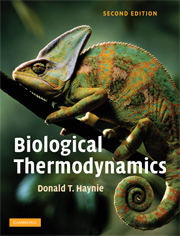Book contents
- Frontmatter
- Contents
- Preface to the second edition
- Chapter 1 Energy transformation
- Chapter 2 The First Law of Thermodynamics
- Chapter 3 The Second Law of Thermodynamics
- Chapter 4 Gibbs free energy – theory
- Chapter 5 Gibbs free energy – applications
- Chapter 6 Statistical thermodynamics
- Chapter 7 Binding equilibria
- Chapter 8 Reaction kinetics
- Chapter 9 The frontier of biological thermodynamics
- Appendices
- Glossary
- Index of names
- Subject index
- References
Chapter 8 - Reaction kinetics
Published online by Cambridge University Press: 05 June 2012
- Frontmatter
- Contents
- Preface to the second edition
- Chapter 1 Energy transformation
- Chapter 2 The First Law of Thermodynamics
- Chapter 3 The Second Law of Thermodynamics
- Chapter 4 Gibbs free energy – theory
- Chapter 5 Gibbs free energy – applications
- Chapter 6 Statistical thermodynamics
- Chapter 7 Binding equilibria
- Chapter 8 Reaction kinetics
- Chapter 9 The frontier of biological thermodynamics
- Appendices
- Glossary
- Index of names
- Subject index
- References
Summary
Introduction
The foregoing chapters focused on practical and applied aspects of thermodynamics and statistical mechanics. These subjects provide ways of thinking about energy transformation, methods for determining the direction of spontaneous change, the magnitude of thermodynamic quantities when a system passes from one state to another, and the molecular origin of change. Useful as they are, however, thermodynamics and statistical mechanics do not tell us everything we'd like to know: they give no direct indication of the rate at which a chemical change will occur nor how the rate of change will vary with conditions.
The present chapter seeks to bridge some of the gaps which remain from a strictly thermodynamic treatment of topics of interest in biochemistry. It might seem counter-intuitive for this chapter to appear next to last instead of first, since one of the most basic aspects of our experience of the world is change. Plants grow, go to seed, and die, while animals move, eat, reproduce, and die. And the molecules bacteria, plants, and animals are made of are always moving. But the title of this book is Biological Thermodynamics, not Biological Kinetics!
As we have seen, analysis of free energy changes provides a way of answering such questions as “Why is most of the energy of glucose harvested in the citric acid cycle and not in glycolysis?”. But in order to respond well to “Does H2CO3 break down fast enough on its own to permit metabolic CO2 to be excreted into the atmosphere?” we must turn to reaction kinetics.
- Type
- Chapter
- Information
- Biological Thermodynamics , pp. 281 - 325Publisher: Cambridge University PressPrint publication year: 2008



